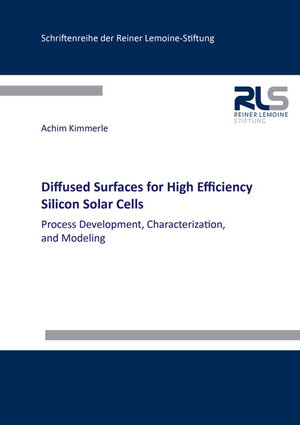
×
![Buchcover ISBN 9783844038200]()
Diffused Surfaces for High Efficiency Silicon Solar Cells
Process Development, Characterization, and Modeling
von Achim KimmerleThe standard method to extract the recombination parameter J0 and the carrier lifetime in the base substrate from lifetime measurements of samples exhibiting diffused surfaces is revised, adapted, and tested on simulation and measurement data sets.
An analytical model for solar cells with locally contacted passivated rear side is adapted to account for injection dependent effects and tested against numerical simulations. The adaption enables modeling devices which are, on the one hand, influenced by injection dependent material parameters and, on the other hand, leave the low-level injection regime.
The effective surface recombination velocity of holes at highly phosphorus-doped surfaces is evaluated and parameterized in dependence of the surface doping concentration for two industrially relevant passivation schemes, both for planar and alkaline textured surfaces.
New processes to form deep driven-in phosphorus diffusions with low surface concentrations in one single process step are developed. A simulation of the recombination behavior in dependence of the process parameters gives additional insight for further development of diffusion processes. A lean, industrially feasible sequence to produce back-contact back-junction solar cells featuring a non-passivated aluminum alloyed emitter is developed. The presented solar cell process requires only one high temperature diffusion step without the need of further dopant sources or diffusion masks. The contacts are applied by screen-printing. A first experimental evaluation is presented that leads to a conversion efficiency of 20.1 %.
An analytical model for solar cells with locally contacted passivated rear side is adapted to account for injection dependent effects and tested against numerical simulations. The adaption enables modeling devices which are, on the one hand, influenced by injection dependent material parameters and, on the other hand, leave the low-level injection regime.
The effective surface recombination velocity of holes at highly phosphorus-doped surfaces is evaluated and parameterized in dependence of the surface doping concentration for two industrially relevant passivation schemes, both for planar and alkaline textured surfaces.
New processes to form deep driven-in phosphorus diffusions with low surface concentrations in one single process step are developed. A simulation of the recombination behavior in dependence of the process parameters gives additional insight for further development of diffusion processes. A lean, industrially feasible sequence to produce back-contact back-junction solar cells featuring a non-passivated aluminum alloyed emitter is developed. The presented solar cell process requires only one high temperature diffusion step without the need of further dopant sources or diffusion masks. The contacts are applied by screen-printing. A first experimental evaluation is presented that leads to a conversion efficiency of 20.1 %.


